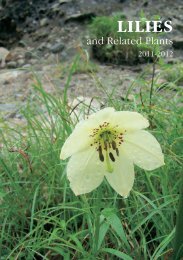LILIES - RHS Lily Group
LILIES - RHS Lily Group
LILIES - RHS Lily Group
Create successful ePaper yourself
Turn your PDF publications into a flip-book with our unique Google optimized e-Paper software.
Right, Lilium chalcedonicum,<br />
individual with 10 flowers<br />
grown in the author’s private<br />
garden in Denmark, originally<br />
from Mt Olympus.<br />
1st August, 1980.<br />
every three years, and hundreds<br />
of plants are now in cultivation<br />
from this introduction. They<br />
are fully hardy and cultivation<br />
is not difficult although it may<br />
be necessary to watch out for lily beetles. Peak flowering is usually around<br />
1 August, and because of the late flowering seeds are not always produced.<br />
5. Lilium rhodopeum<br />
This is the rarest and least known of the Greek lilies. It was first discovered in 1951<br />
in the Rodhopi mountains of southern Bulgaria and described in the following<br />
year. It has subsequently been found in a few more localities in this area as well<br />
as south of the border, growing in secondary pastures in clearings of coniferous<br />
or beech forest at altitudes between 1200 and 1800 m (see pp.25). It is a stout<br />
plant, 40-90 cm tall, appearing from a large bulb with plump whitish scales. The<br />
stem is covered with scattered lanceolate leaves almost up to the flowers. The<br />
latter are conspicuously large (8-14 cm in diameter) with a long slender base and<br />
Lilium Distribution martagon of<br />
Distribution of<br />
Lilium chalcedonicum<br />
Lilium martagon<br />
Lilium chalcedonicum<br />
24




